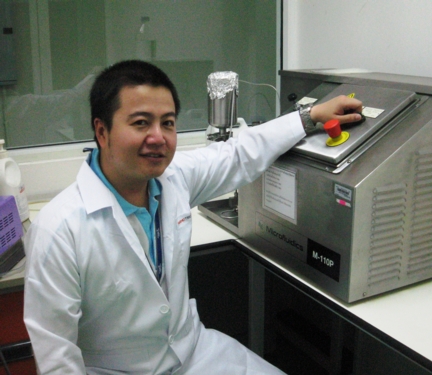Home > Press > First to use microfluidization for cassava starch modification
 |
Abstract:
Researchers at National Nanotechnology Center (NANOTEC) have discovered that using microfluidization has an effect on the structure and thermal properties of cassava starch-water suspension (20% w/w).
First to use microfluidization for cassava starch modification
Pathumthani, Thailand | Posted on July 8th, 2011"This is the first time that anyone has ever used microfluidization for cassava starch modification" said Dr. Kittiwut Kasemwong, researcher at NANOTEC Nano-Delivery Lab. "After using the microfluidization treatment, we noticed bigger starch granule was partially gelatinized, and a gel-like structure was formed on a granular surface. Our investigation indicates that high- pressure microfluidization process induce the gelatinization process which is crucial for granule swelling and water access".
This discovery has many application potentials in the food and drug industry. According to the Thai Board of Investment (BOI), the Thai food industry generates about $15 billion dollars annually and comprises about 30% of GDP. As for the drug industry, it is estimated that by 2016 Thailand will have the seventh largest pharmaceutical market in the Asia Pacific region.
Collaborators on this investigation included researchers from Srinakharinwirot University and Kasetsart University. The researchers reported their investigation in a paper published by Starch - Starke.
####
For more information, please click here
Contacts:
Ramjitti Indaraprasirt
Manager
International Relations Section
NANOTEC
02-564-7100 ext: 6617
Copyright © NANOTEC
If you have a comment, please Contact us.Issuers of news releases, not 7th Wave, Inc. or Nanotechnology Now, are solely responsible for the accuracy of the content.
| Related News Press |
News and information
![]() Researchers develop molecular qubits that communicate at telecom frequencies October 3rd, 2025
Researchers develop molecular qubits that communicate at telecom frequencies October 3rd, 2025
![]() Next-generation quantum communication October 3rd, 2025
Next-generation quantum communication October 3rd, 2025
![]() "Nanoreactor" cage uses visible light for catalytic and ultra-selective cross-cycloadditions October 3rd, 2025
"Nanoreactor" cage uses visible light for catalytic and ultra-selective cross-cycloadditions October 3rd, 2025
Discoveries
![]() Researchers develop molecular qubits that communicate at telecom frequencies October 3rd, 2025
Researchers develop molecular qubits that communicate at telecom frequencies October 3rd, 2025
![]() Next-generation quantum communication October 3rd, 2025
Next-generation quantum communication October 3rd, 2025
![]() "Nanoreactor" cage uses visible light for catalytic and ultra-selective cross-cycloadditions October 3rd, 2025
"Nanoreactor" cage uses visible light for catalytic and ultra-selective cross-cycloadditions October 3rd, 2025
Announcements
![]() Rice membrane extracts lithium from brines with greater speed, less waste October 3rd, 2025
Rice membrane extracts lithium from brines with greater speed, less waste October 3rd, 2025
![]() Researchers develop molecular qubits that communicate at telecom frequencies October 3rd, 2025
Researchers develop molecular qubits that communicate at telecom frequencies October 3rd, 2025
![]() Next-generation quantum communication October 3rd, 2025
Next-generation quantum communication October 3rd, 2025
![]() "Nanoreactor" cage uses visible light for catalytic and ultra-selective cross-cycloadditions October 3rd, 2025
"Nanoreactor" cage uses visible light for catalytic and ultra-selective cross-cycloadditions October 3rd, 2025
Food/Agriculture/Supplements
![]() New imaging approach transforms study of bacterial biofilms August 8th, 2025
New imaging approach transforms study of bacterial biofilms August 8th, 2025
![]() SMART researchers pioneer first-of-its-kind nanosensor for real-time iron detection in plants February 28th, 2025
SMART researchers pioneer first-of-its-kind nanosensor for real-time iron detection in plants February 28th, 2025
![]() Silver nanoparticles: guaranteeing antimicrobial safe-tea November 17th, 2023
Silver nanoparticles: guaranteeing antimicrobial safe-tea November 17th, 2023
|
|
||
|
|
||
| The latest news from around the world, FREE | ||
|
|
||
|
|
||
| Premium Products | ||
|
|
||
|
Only the news you want to read!
Learn More |
||
|
|
||
|
Full-service, expert consulting
Learn More |
||
|
|
||








